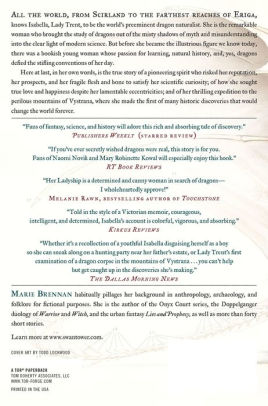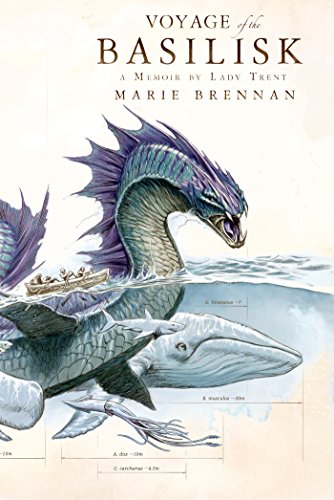Marie Brennan begins a thrilling new fantasy series in A Natural History of Dragons, combining adventure with the inquisitive spirit of the Victorian Age. You, dear reader, continue at your own risk. It is not for the faint of heart—no more so than the study of dragons itself. Dragon's blood was once prized as a medicine in Europe and the Middle East. According to the early Roman naturalist Pliny the Elder, it formed when dragons attacked elephants, and their blood ran together and congealed. The skull of a woolly rhinoceros (Coelodonta antiquitatis) was once kept in the town hall of Klagenfurt, Austria. It was said to be the remains of a dragon slain before the city was founded around AD 1250. A Natural History of Dragons is a faux-memoir by an aristocratic lady scientist, a dragon enthusiast. The book had a very strong start, the chapters on her childhood are so promising, and the commentary on women's total legal dependancy on their husbands was very interesting. Posts about a natural history of dragons written by nikihawkes. Speculative Fiction Book Reviews by Niki Hawkes (for those in need of some seriously good reading)!
Origin Of Dragons
Kate Murray, Staff Reporter
September 30, 2014
Ahem. Dragons. This book contains dragons, and if I didn’t have to write a full length article, I would leave my review at that. However, since I do, there are a few other things I would like to say.
A Natural History of Dragons, by Marie Brennan, is the fictional biography of Lady Trent, a woman who has been described as “the Jane Goodall of dragonkind.” Unlike Goodall, however, this book is set in a Victorian era world, where women working in science is an even rarer occurrence than seeing a dragon, and as such, there is a heavy emphasis on the many ways in which Lady Trent overcomes sexism and follows her passions. A good example would be the time a wolf-drake was spotted in her area. Her father wouldn’t let her come on a hunt for it, so she blackmailed a servant into giving her his clothes and went along disguised as a man.
The wolf-drake was not what sparked her interest in dragons, however. In the beginning of the book Brennan talks about the tiny, six-legged dragons known as sparklings that fascinated Trent as a young girl. Trent at this point was less enthusiastic about dragons, and more about flight in general, which led to the messy, and frowned upon, impromptu dissection of a dead pigeon. Disgusted by this her father gave her access to his library so she wouldn’t have to use such an unladylike way of gathering information again, and this is where she found A Natural History of Dragons, the books’ namesake and the starting point for her adventures.

As I mentioned, however, her adventures are more than just playing with dragons. There is a very heartening message of overcoming boundaries set by others and learning new things through trial and error. There is a prominent subplot of Trent adjusting to a new culture and learning that just because she thinks the people are savage doesn’t mean they truly are, an important theme in today’s America. Though the culture Trent visits is based off Russia, the idea of it can also be applied to many Middle Eastern and African cultures, which are not all poor and/or full of terrorists, whatever politicians may say.
Harry potter google doc. Overcoming the sexism of the day is not a topic lost on me, either. There is still sexism in the world, and a story where the main character overcomes this is definitely to be appreciated.
This relevance to the real world and the detailed writing style combined to give an impression that the book wasn’t from another world at all. Yes, there were dragons and continents that don’t exist on Earth, but the wool was pulled right over my eyes by the people and settings. It felt less like fantasy and more like historical fiction, and an entertaining fiction at that.
The sequel is “Tropic of Serpents” and both of them are available at your wonderful local library.
Kate is a senior and the copy editor of the newspaper. She knows what is going on in the school because the resident alliance of cockroach and mice spies..
Kate Murray, Staff Reporter
September 30, 2014
Ahem. Dragons. This book contains dragons, and if I didn’t have to write a full length article, I would leave my review at that. However, since I do, there are a few other things I would like to say.
A Natural History of Dragons, by Marie Brennan, is the fictional biography of Lady Trent, a woman who has been described as “the Jane Goodall of dragonkind.” Unlike Goodall, however, this book is set in a Victorian era world, where women working in science is an even rarer occurrence than seeing a dragon, and as such, there is a heavy emphasis on the many ways in which Lady Trent overcomes sexism and follows her passions. A good example would be the time a wolf-drake was spotted in her area. Her father wouldn’t let her come on a hunt for it, so she blackmailed a servant into giving her his clothes and went along disguised as a man.
The wolf-drake was not what sparked her interest in dragons, however. In the beginning of the book Brennan talks about the tiny, six-legged dragons known as sparklings that fascinated Trent as a young girl. Trent at this point was less enthusiastic about dragons, and more about flight in general, which led to the messy, and frowned upon, impromptu dissection of a dead pigeon. Disgusted by this her father gave her access to his library so she wouldn’t have to use such an unladylike way of gathering information again, and this is where she found A Natural History of Dragons, the books’ namesake and the starting point for her adventures.
As I mentioned, however, her adventures are more than just playing with dragons. There is a very heartening message of overcoming boundaries set by others and learning new things through trial and error. There is a prominent subplot of Trent adjusting to a new culture and learning that just because she thinks the people are savage doesn’t mean they truly are, an important theme in today’s America. Though the culture Trent visits is based off Russia, the idea of it can also be applied to many Middle Eastern and African cultures, which are not all poor and/or full of terrorists, whatever politicians may say.
Overcoming the sexism of the day is not a topic lost on me, either. There is still sexism in the world, and a story where the main character overcomes this is definitely to be appreciated.

This relevance to the real world and the detailed writing style combined to give an impression that the book wasn’t from another world at all. Yes, there were dragons and continents that don’t exist on Earth, but the wool was pulled right over my eyes by the people and settings. It felt less like fantasy and more like historical fiction, and an entertaining fiction at that.
Dragon History Facts


The Natural History Of Dragons Free
The sequel is “Tropic of Serpents” and both of them are available at your wonderful local library.
A Natural History Of Dragons Summary
Kate is a senior and the copy editor of the newspaper. She knows what is going on in the school because the resident alliance of cockroach and mice spies..
